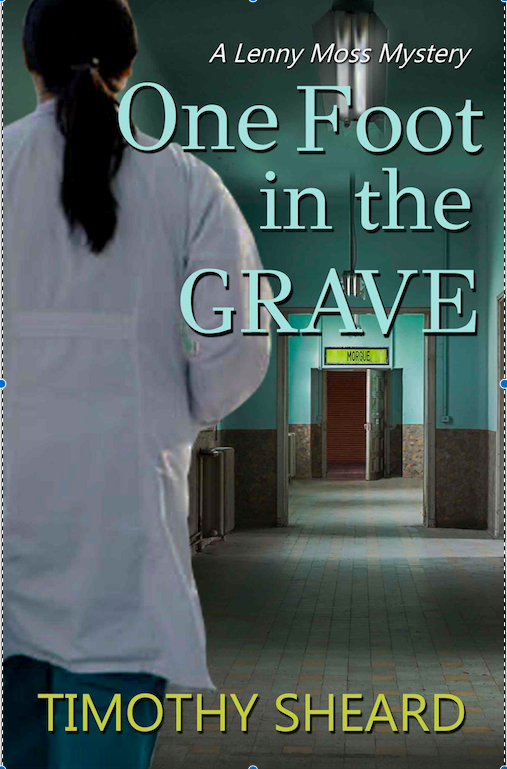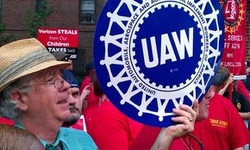
Brooklyn, NY – Good murder mysteries ultimately keep you guessing “whodunit?” Tim Sheard’s Lenny Moss murder mysteries ultimately keep you guessing “whodunit?” — and “how-will-workers-secure-a-collective-bargaining-agreement-that-guarantees-area-standard-wages-and-benefits-plus-a-dignified-retirement?”
“There are some people who will read my books because they like mysteries or they like medical stories, maybe they work in the health field,” the author, organizer and Hard Ball Press publisher says over a coffee on Cortelyou Road. “By drawing them in as a mystery reader or a medical story reader they say, ‘Wait a minute! There’s a struggle; there’s a union story in there!’ It’s my way of drawing in people from outside the sphere of the Labor Movement.”
“One Foot In The Grave” is, in fact, Sheard’s eighth Lenny Moss mystery and finds the tenacious service worker valiantly trying to help organize hospital staffers simultaneously caught in the grips of a nasty outbreak of Zika virus and a vengeful madman who’ll kill anyone who dares get in his way. (Sheard’s killer comes across as a chilling mix of Hannibal Lecter and The Joker).
“There is an underlying structure to a mystery story,” Sheard explains. “The first is the crime with the question: Will my protagonist uncover the culprit? But I also like to include a labor struggle because Lenny Moss is a shop steward. And then I usually also have at least one medical condition; a patient to follow through the book. Usually, there are three interwoven stories that go together to form the novel.”
From the outset, publishers interested in Lenny Moss, were, nevertheless, also leery about a protagonist who worked as a janitor and pressed Sheard to give his unofficial detective a professional sheen — like a doctor. But the Brooklyn author would not hear of it.
“I said no, I want my protagonist to be a good, blue collar, working class guy,” Sheard recalls.
For Sheard, Lenny Moss’ identity is vital because stories are vital — and enormously powerful.
“When you read a story you walk in the shoes of the character,” he says. “You feel the character’s pain; you laugh when they say something funny; you’re excited when they win. A story can really build empathy between the reader and the character. And when the character represents unions then it can really build solidarity with the Labor Movement — people can really feel the pressure, feel the pain — feel the hope that the characters do as they struggle for their union.”
Union solidarity is something Sheard thought a lot about when penning Lenny Moss’ latest adventure. In “One Foot In The Grave,” efforts to unionize the staff of James Madison Hospital comes in response to management’s careless disregard for the safety of all workers but is stymied when some bristle at the idea of organizing with “non-professionals.”

It’s a phenomenon Sheard sees played out in real life, notably within the healthcare industry.
“There’s been a rise of professional unions in healthcare, which is good; it’s good that you’re unionizing the pharmacists and the nurses,” Sheard says. “But when workers are divided in any business or institution, it means you are weaker. You’re weaker when you’re fighting alone; you’re stronger when you’re together.”
Fifty years ago, nearly a third of American workers belonged to a union — and books, movies, art and theater, played a huge part in inspiring worker solidarity and the success of the American Labor Movement.
“A lot of the union halls had dances; they had music; they had readings; they had artwork,” Sheard explains. “But nowadays, unions are kind of under the gun. They’re really under a lot of pressure. It’s hard for them to put together the ‘Bread & Roses’ festivals that they used to do. I think it would be a great thing if they did it again because it builds more solidarity within the union when you’re doing more than handling the business aspect. When you’re bringing people into the union hall for dances, for music and recitals — that builds love for the union.”
Those days may or may not ever return — but in the meantime, there is Lenny Moss to intrigue and inspire.
“A lot of young people today don’t know what a labor union does; they don’t now the history of labor unions,” Sheard says. “But, if you can get them to read a story…if you can get them to do that… then you can inform them.”
Pick up a copy of the Lenny Moss mysteries here.

